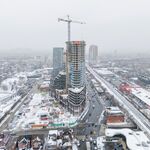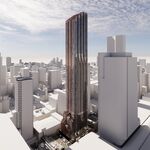You are using an out of date browser. It may not display this or other websites correctly.
You should upgrade or use an alternative browser.
You should upgrade or use an alternative browser.
Cycling infrastructure (Separated bike lanes)
- Thread starter MetroMan
- Start date
afransen
Senior Member
Flexiposts are not bollards. Bollards stop vehicle incursions. Flexiposts make a mildly annoying thwacking sound before you mow down cyclists/pedestrians.Here's a link to the tweet for those who, like me, wanted to see the glorious, full-sized pics:
smably
Senior Member
Fortunately, here they're mounted on concrete curbs, so there's at least some protection.Flexiposts are not bollards. Bollards stop vehicle incursions. Flexiposts make a mildly annoying thwacking sound before you mow down cyclists/pedestrians.
DirectionNorth
Active Member
I prefer flexiposts to nothing - they slow down drivers, and makes drivers think about drifting too far into the bike lane.Flexiposts are not bollards. Bollards stop vehicle incursions. Flexiposts make a mildly annoying thwacking sound before you mow down cyclists/pedestrians.
W. K. Lis
Superstar
With flexiposts, they may scratch their vehicle's paint job. With bollards, they may end up with dents, or worse.I prefer flexiposts to nothing - they slow down drivers, and makes drivers think about drifting too far into the bike lane.
DirectionNorth
Active Member
Don't get me wrong - I much prefer concrete and bollards over the flexiposts, but the psychological effect is the same as narrowing the road - it slows them down and makes them more aware of their surroundings.With flexiposts, they may scratch their vehicle's paint job. With bollards, they may end up with dents, or worse.
afransen
Senior Member
I was merely correcting the City's incorrect terminology. Bollards are widely used to actually protect pedestrians/vulnerable road users. Flexiposts are merely a psychological tool or incentivize people not to ruin their paint job but won't stop a granny with unintended acceleration from plowing through a farmer's market.
Admiral Beez
Superstar
Here's the reply....Ms. Katz replied that she’s meeting with the TTC in mid August to discuss moving the TTC stop at Dundas at River so to allow a hardened separation.
Evening,
I just wanted to provide an update. I met with TTC a week later than expected. As discussed below, since bus's accessible ramps cannot be deployed down to street level, buses cannot stop in the middle streetcar lane if there is bus replacement on the Dundas Street corridor (planned or unplanned). Thus protection cannot be added along the full length of the Dundas corridor at this point in time.
TTC does support shortening the length of the transit stops. Right now the bikeway protection stops more than 40 m from the streetcar stops. They have agreed to reduce to 30m. I know this will not solve all the issues highlighted, but it will help to reinforce that the space is meant for people cycling.
Currently the protected bike lanes on Dundas Street between Broadview and Sackville are temporary as part of ActiveTO. We are required to report to City Council at the end of the year.
Depending on the next round of data collection results and staff recommendations, City Council will determine if the ActiveTO bikeways should be made permanent, stay temporary or be removed (and perhaps debate addition unanticipated options as determined by City Council members or through staff recommendations). If they are made permanent, the streetcar stops could be upgraded with raised transit/bike islands found across the city including on Sherbourne, Howard Park at Dundas, Lake Shore Boulevard W near Norris, etc. The pavement markings could also be upgraded from paint to thermoplastic.
Please let me know if you have any questions,
Becky
Becky Katz (she/her)
Manager, Cycling and Pedestrian Projects
Transportation Services
City of Toronto
And my reply:
"Hi Becky, A belated thank you for your email. I wanted to observe the intersection a little longer before replying. It's downright dangerous and needs to be addressed. If we cannot extend the protection for the cyclists then the best solution is to eliminate the illusion of protection, meaning that the solid painted line needs to be removed and the right hand lane reestablished for right turning vehicular traffic. As it is now, there is no clearly understood place for cars that want to turn right from Dundas to River, with some venturing into the bicycle lane whilst others stay to the left with their right turn indicators on, only to be nearly sideswiped by other cars that use the bicycle lane to pass on the right. All the while the bicycle riders are trying to avoid getting caught up in the confusing ruckus."
Last edited:
DSCToronto
Superstar
Member Bio
- Joined
- Jan 13, 2008
- Messages
- 20,056
- Reaction score
- 29,401
- Location
- St Lawrence Market Area
The Bike lanes on Mill & The Esplanade are moving onwards. https://www.toronto.ca/wp-content/u...splMill-Phase-1-Construction-Notice-Final.pdf
imerk
Active Member
The Bike lanes on Mill & The Esplanade are moving onwards. https://www.toronto.ca/wp-content/u...splMill-Phase-1-Construction-Notice-Final.pdf
Interesting, Mill Street east of Cherry Street already has fairly new bike lanes which I sort of wish were just continued westward. I kind of hate one way streets when there isn't a viable one way in the opposite direction to balance it out. Converting one ways often ends up with a lot of detouring traffic and a higher number of intersections impacted.
I'd prefer they removed the parking lane and maintained two-way traffic.
W. K. Lis
Superstar
Found a lot of the garages are being used as storage units. They hold their garden equipment, camping equipment, winter/summer tires, BBQ, handi-person tools, workbench, wine-making bottles, etc.. Oh yes, fogot about parking for the bicycles, of course. This results in the car having to be parked on the streets because they have no more room available in the garage.Interesting, Mill Street east of Cherry Street already has fairly new bike lanes which I sort of wish were just continued westward. I kind of hate one way streets when there isn't a viable one way in the opposite direction to balance it out. Converting one ways often ends up with a lot of detouring traffic and a higher number of intersections impacted.
I'd prefer they removed the parking lane and maintained two-way traffic.
DSCToronto
Superstar
Member Bio
- Joined
- Jan 13, 2008
- Messages
- 20,056
- Reaction score
- 29,401
- Location
- St Lawrence Market Area
What are you talking about? There are NO garages along either The Esplanade or Mill Street that might be filled with 'stuff' so that cars need to park in the street. This MAY be something seen in single family houses but the buildings on these streets are all MURBs.Found a lot of the garages are being used as storage units. They hold their garden equipment, camping equipment, winter/summer tires, BBQ, handi-person tools, workbench, wine-making bottles, etc.. Oh yes, fogot about parking for the bicycles, of course. This results in the car having to be parked on the streets because they have no more room available in the garage.
W. K. Lis
Superstar
Not talking about the MURBs, but the single-family houses in Toronto, the 905, etc. with private garages. Those ones end up getting filled with everything except the family car.What are you talking about? There are NO garages along either The Esplanade or Mill Street that might be filled with 'stuff' so that cars need to park in the street. This MAY be something seen in single family houses but the buildings on these streets are all MURBs.
DSCToronto
Superstar
Member Bio
- Joined
- Jan 13, 2008
- Messages
- 20,056
- Reaction score
- 29,401
- Location
- St Lawrence Market Area
Yes, but the discussion was about bike lanes on The Esplanade.Not talking about the MURBs, but the single-family houses in Toronto, the 905, etc. with private garages. Those ones end up getting filled with everything except the family car.
imerk
Active Member
I know my condo and every condo I've lived in strictly prohibits the storage of any goods other than a vehicle in your parking space, so I haven't really experienced this phenomenon.




